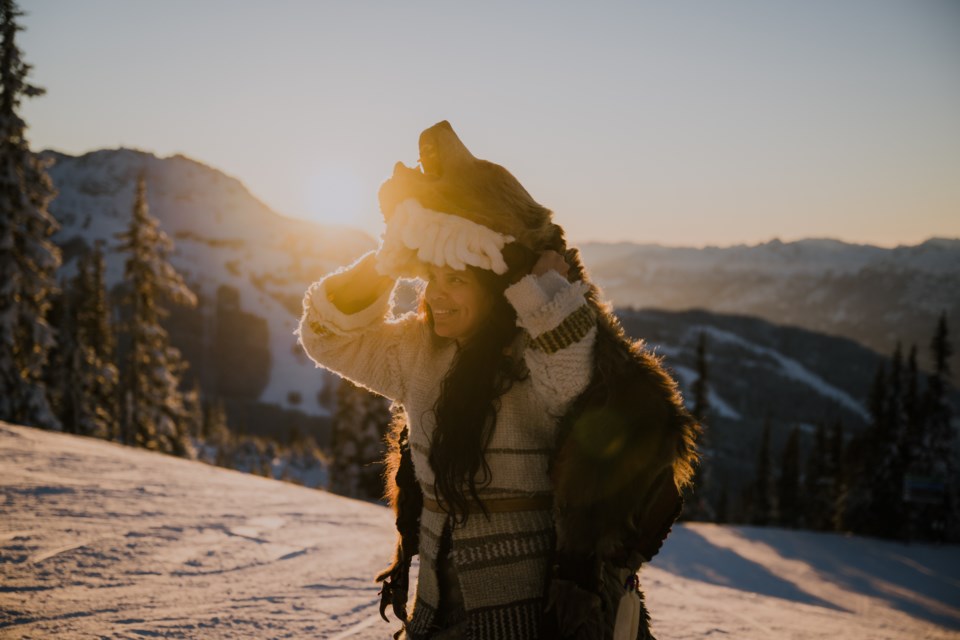In the early ’90s, Macáoz’alus (HuckleberryEyes)/Jackie Andrew’s father, Lil’wat Nation Chief Leonard Andrew, was part of a campaign to protect the Stein Valley watershed, a key grizzly bear habitat and now a protected park.
Today, Andrew herself is a traditional bear dancer—a sacred animal the Lil’wat people have had a unique relationship with since time immemorial. The dancers wear the traditional grizzly bear hide and honour the magnificent creature.
“In comparison, both spiritually and physically, grizzlies are very much like ucwalmicw (people); we are all advocates, keepers of the land,” Andrew said. “These are our sacred teachings and laws which protect all life on good Mother Earth. It is each of our responsibility as a human race to protect the grizzly (st̓alhálam) and the habitat.”
But the time to act carefully is now, as grizzly habitat is in a critical state, Andrew said, noting natural food sources are being impacted by fires and floods.
And grizzly bears were in the area long before settlers arrived, she added.
“They are the true keepers of the land. We must be more like the grizzly and protect all the sources that we use. That is our traditional law of Lil’wat that has been passed down since time immemorial,” she said.
“It all comes down to our traditional laws that govern how we see the world, how we walked and talked, how we fished for salmon and how we harvested. Our worldview about bears is very different. Our ancestors had a traditional law and our whole life was governed on this.”
Though there are photos of Andrew dancing in the traditional grizzly hide displayed all over B.C., she explained she is only a caretaker of the hide, and would never, ever hunt the sacred creature.
“I dance in a traditional hide, but I have never hunted it,” she said. “It’s always just been passed down to us in a way that it could be used in a good way. We don’t even look at it as owning this grizzly hide or this bear robe. I would never hunt the grizzly. I grizzly bear dance because I am a twin. As we carry the bear medicine.
“We have such a high value for all animals, all living things, like the trees. The land is sacred. The waterways are sacred. It’s important to teach my children that many non-natives that are trying to protect the land are now finally looking at us as protectors. We are leading the way with what we have been taught.”
The people of Lil’wat Nation do not see themselves as above other creatures in their home. Animals are included in their prayers, their teachings and their plans, Andrew said.
“We include our neighbours, other cultures, the two-legged, the four-legged, the winged ones, in our traditional laws, but also our prayers,” she said. “We have a term in Ucwalmícwts, ‘takem swa nsnuknukwa7.’ It translates to ‘all my relations,’ and that is part of our worldview and prayers. It helps us keep in mind our priorities of everyone and everything that is related in the world around us.”
There is much for the world to learn from the Lil’wat Nation and other First Nation cultures, but an emphasis on future generations and the greater good for all is perhaps the most enduring.
"We are always thinking of the seventh generation principal.This is a huge teaching that our people have passed down since time immemorial,” Andrew said. “For anything that we do today, we have to think about how it will affect seven generations ahead of us. We want a sustainable world for present and future generations."
The accompanying photos of Andrew in the traditional grizzly bear hide are part of the Squamish Lil'wat Cultural Centre's Unceded exhibition curated by Mixalhítsa7 (Alison Pascal) and Tsawaysia (Dominique Nahanee). More information about the collection can be found here.




